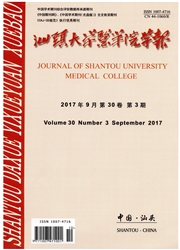

 中文摘要:
中文摘要:
目的:观察碘化N-正丁基氟哌啶醇(F2)对缺氧复氧(H/R)条件下大鼠心脏微血管内皮细胞(RCMECs)早期生长反应基因-1(Sgr-1)表达的影响。方法:体外培养RCMECs,建立其H/R模型。细胞随机分为对照组,H/R组,溶剂(PEG)组和F2组。在细胞缺氧3h复氧2h后收集细胞及上清液,免疫细胞化学法检测细胞中Eg-1蛋白的表达水平,显微镜下观察细胞形态学改变并计算存活率。结果:H/R及PEG组内皮细胞在H/R刺激下Egr-1蛋白表达明显升高,细胞形态发生改变。存活率降低。F2组的内皮细胞在H/R刺激下Egr-1的异常表达受抑制,细胞形态结构无明显改变,细胞存活率提高。结论:R对体外培养的RCMECsH/R损伤具有保护作用,这可能与其抑制Egr-1蛋白过表达有关。
 英文摘要:
英文摘要:
Objective: To study the effect of N-n-butyl haloperidol iodide(F2)on Egr-1 expression of rat cardiac microvascular endothelial cells( RCMECs) induced by hypoxia and reoxgenation. Methods: RCMECs were cultured /n v/tro and the hypoxia-reoxgenation(H/R)model was established. Cells were divided at random into control, H/R, PEG and F2 groups. Cells and cultured supematants were collected after 3 hours hypoxia and 2 hours reoxgenation. Egr-1 expres- sion of endothelial cells was determined by immunocytochemical method. Cell morphology and cell viability were observed to assess the degree of injury. Results: In the H/R and PEG groups, the expression of egr-1 protein of RCMECs treated with H/R increased markedly. The cell morphology changed and cell survival was decreased. In the F2 group, egr-1 protein expression of RCMECs was down-regulated, the cell morphology and cell survival were improved. Conclusion: F2 can protect RCMECs from the injury of H/R, which might be related with the down-regulation of egr-1 protein expression.
 同期刊论文项目
同期刊论文项目
 同项目期刊论文
同项目期刊论文
 Effects of N-n-butyl haloperidol iodide on the rat myocardial sarcoplasmic reticulum Ca(2+)-ATPase d
Effects of N-n-butyl haloperidol iodide on the rat myocardial sarcoplasmic reticulum Ca(2+)-ATPase d N-n-butyl haloperidol iodide ameliorates cardiomyocytes hypoxia/reoxygenation injury by extracellula
N-n-butyl haloperidol iodide ameliorates cardiomyocytes hypoxia/reoxygenation injury by extracellula N-n-Butyl haloperidol iodide inhibits the augmented Na+/Ca2+ exchanger currents and L-type Ca2+ curr
N-n-Butyl haloperidol iodide inhibits the augmented Na+/Ca2+ exchanger currents and L-type Ca2+ curr N-n-Butyl haloperidol iodide inhibits the augmented Na(+)/Ca(2+) exchanger currents and L-type Ca(2+
N-n-Butyl haloperidol iodide inhibits the augmented Na(+)/Ca(2+) exchanger currents and L-type Ca(2+ The protective effects of Egr-1 antisense oligodeoxyribonucleotide on cardiac microvascular endothel
The protective effects of Egr-1 antisense oligodeoxyribonucleotide on cardiac microvascular endothel N-n-butyl Haloperidol Iodide Protects Cardiac Microvascular Endothelial Cells From Hypoxia/Reoxygena
N-n-butyl Haloperidol Iodide Protects Cardiac Microvascular Endothelial Cells From Hypoxia/Reoxygena Design, Synthesis, and Pharmacological Evaluation of Haloperidol Derivatives as Novel Potent Calcium
Design, Synthesis, and Pharmacological Evaluation of Haloperidol Derivatives as Novel Potent Calcium 期刊信息
期刊信息
